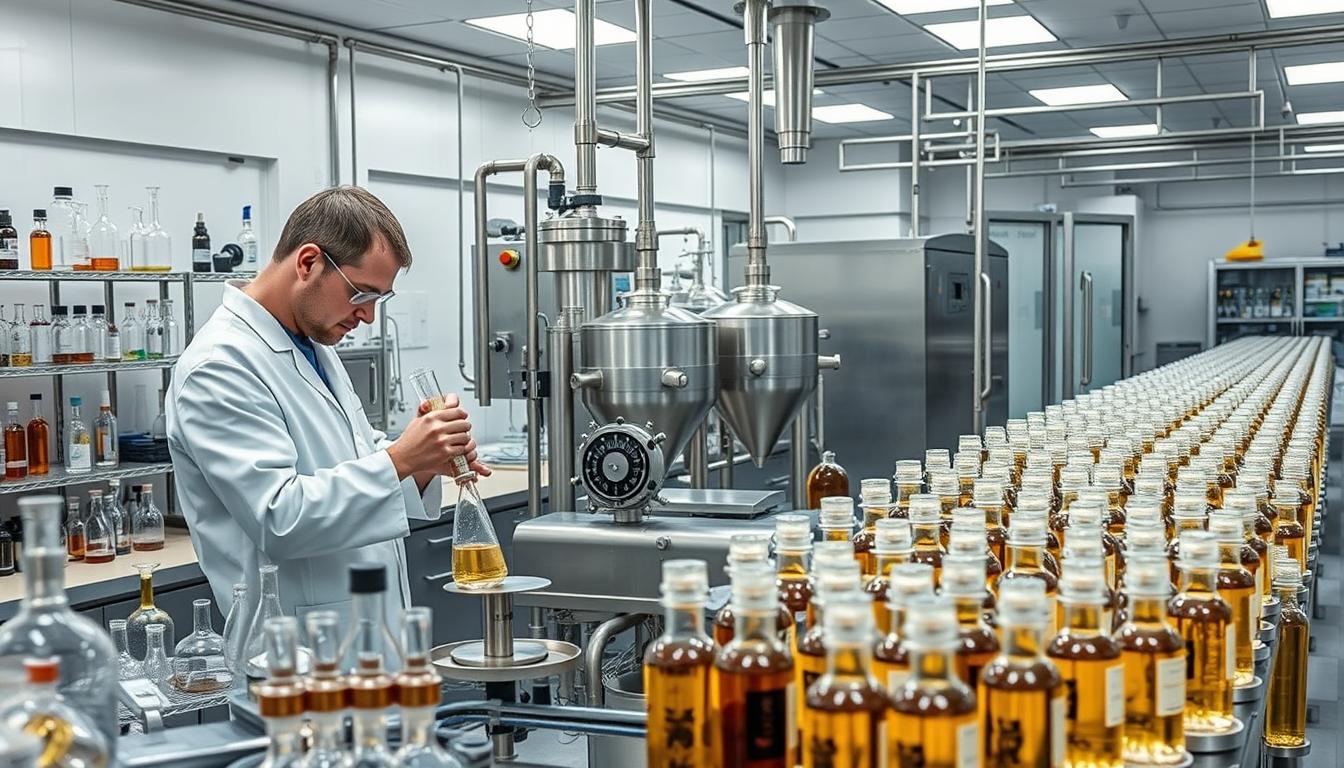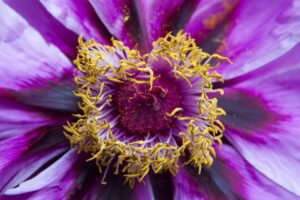In a magical part of a botanical garden, petals lie peacefully on a pond. The air is filled with a beautiful, complex fragrance that touches our hearts and minds. This magical mix of nature’s smells is the beginning of perfume-making. This art form has deep roots in history but has also embraced modern ways. The process of making fragrances has become more than just making something smell nice. It’s now a way to show who you are.
People from long ago and far away lands have always been drawn to unique scents. That’s why today’s perfume industry blends old traditions with new science. This mix creates a world of smells that invites us to explore hidden, sweet-smelling gardens.
Key Takeaways
- The perfume manufacturing process fuses time-honored techniques with cutting-edge fragrance creation science.
- Aromatic compounds crucial to scent production are skillfully extracted through traditional and modern technology, resulting in exceptional fragrances.
- Perfumers use a wide range of aroma creation techniques to capture the essence of both natural ingredients and synthetic aromas for a captivating scent experience.
- The art of perfumery requires a deep understanding of how various ingredients interact and unfold over time to enchant the senses.
- Every bottle of perfume is a testament to the meticulous craftsmanship that perfects the balance of top, middle, and base notes through the industry’s best practices.
A Journey Through Time: The Evolution of Perfume Manufacturing
The art of making perfume is ancient, over 4,000 years old. It has grown, using natural scents and new science to make fragrances we love. This evolution from ancient perfume manufacturing to modern perfumery techniques shows our culture and creativity.
Originally, perfume wasn’t just for smell; it was important in religious and royal events. In places like Mesopotamia and Egypt, oils like myrrh and frankincense were signs of social and spiritual status.
The historical evolution of perfume-making changed a lot with the Industrial Revolution. It turned perfume from a craft to a worldwide business. This change began modern perfumery techniques, making different scents more available.
Now, the perfume world combines old ways and new science. Ancient methods meet modern science in making scents. To see how this mix shapes current perfume creation, visit the exploration of fragrance art.
Perfume’s link to culture is clear through time—each era adds uniquely to the scent world.
This table shows how perfume making moved from old to new ways. It shows both what has continued and what has changed in the industry.
| Aspect | Ancient Techniques | Modern Innovations |
|---|---|---|
| Base Ingredients | Myrrh, Frankincense | Synthetic Molecules |
| Method of Extraction | Manual Extraction | Steam Distillation |
| Cultural Significance | Spiritual and Royal Symbolism | Lifestyle and Personal Identity |
| Technological Integration | Minimal | Significant, Biotechnology |
Understanding how perfume has changed shows our deep link to the past. The true spirit of perfume blends emotions and memories with scent. It brings together the old and new in every scent we experience.
The Art and Science of Perfumery: From Concept to Fragrance
Making a fragrance is both an art and a science. It uses perfume chemistry to create amazing scents. It’s important to know the parts of a fragrance and how long they last on the skin. Top notes are the first scent you smell and last about 15 to 30 minutes. Next come the middle notes or heart notes. They are the core of the perfume and stay for several hours. Base notes make the scent last longer. They start to show up around 30 minutes after putting the perfume on.
We should look at the different perfume strengths and their effects. Each type, from Parfum to Eau de Cologne, gives a different scent experience:
| Type of Perfume | Concentration of Fragrance Oils | Expected Longevity |
|---|---|---|
| Parfum | 20-30% | Longest-lasting |
| Eau de Parfum (EDP) | 15-20% | Long lasting |
| Eau de Toilette (EDT) | 5-15% | Moderate |
| Eau de Cologne (EDC) | 2-5% | Short |
| Body Mists/Sprays | Less than 3% | Very Short |
Creating a new scent can take over a year, especially for unique niche perfumes. This long process is for testing and perfecting the fragrance. Experts called ‘noses’ help make sure every scent smells great. They also check for consistency and follow the rules.
Perfume companies are now thinking more about the planet. They use eco-friendly packaging and ingredients that are responsibly sourced. This is especially true for niche brands that value being unique and real. In the end, blending creativity with science makes a fragrance more than just a scent. It makes it a work of art, following the rules of perfume chemistry.
Natural vs. Synthetic: Understanding Fragrance Ingredients
The world of perfumery balances natural vs. synthetic fragrance ingredients. Natural elements like essential oils and synthetic parts are both crucial. They help create scents that draw us in. Knowing about these ingredients makes us appreciate perfume more. It shows the skill and science behind fragrance making.
The Role of Essential Oils in Perfume Creation
Essential oils in perfumery are key to creating scents. They come from flowers, fruits, and spices. Processes like steam distillation and solvent extraction are used. These oils add complexity that synthetics try to mimic. They’re chosen for their scents and how they change from first application to the end.
Synthetic Aromatics and Their Impact on Modern Fragrances
Synthetic aroma chemicals are vital for today’s perfumes. They bring versatility and stability. These chemicals can copy natural scents that are hard or not eco-friendly to get. They also help make scents last longer and stay consistent.
Naturals and synthetics together create a special blend. This mix lets each type show its best. Perfume types vary in their fragrance oil concentrations. For example, eau de cologne has 2-5%, while parfum has 20-30%.
Learning about natural and synthetic ingredients helps everyone understand perfume’s artistry. The industry grows with new balance between enjoying scents and being sustainable. So, through the richness of rose oil or the freshness of synthetic linalool, perfume continues to fascinate and motivate.
Perfume Manufacturing Process How Perfume Is Made Fragrance Creation Science
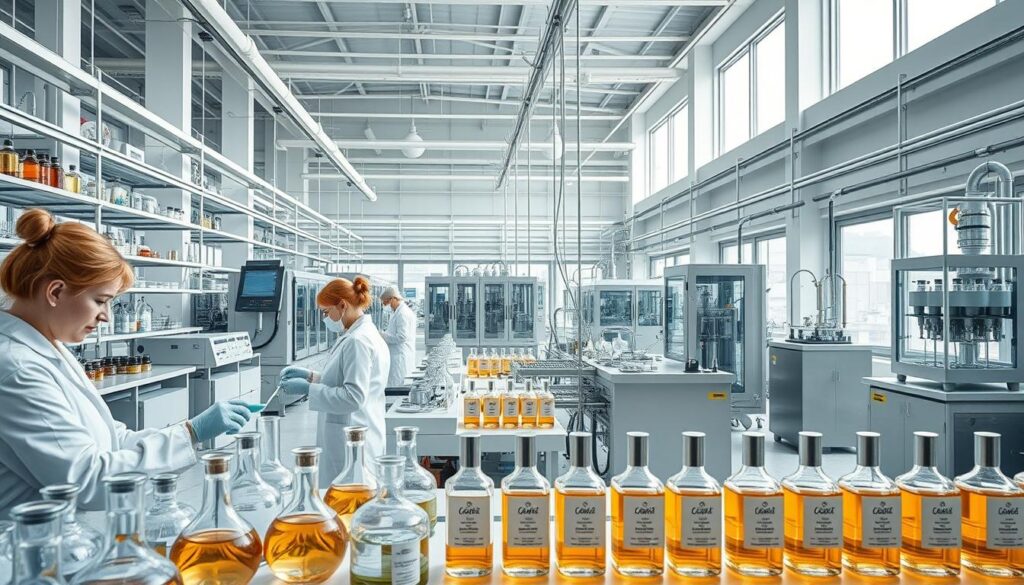
The art of making a captivating scent mixes science with creativity. It starts with choosing the right raw materials. These can be natural, like flowers and barks, or man-made. Then, these ingredients are turned into essence using methods old and new.
First, perfume makers pick various natural and synthetic ingredients. Natural ones like rose and vanilla give rich aromas. Synthetics help keep the fragrance consistent and long-lasting.
Mixing these ingredients is next. A perfumer carefully chooses how much of each to use. They aim for a perfect scent harmony. The right chemicals are added to make sure the scent stays on the skin longer.
The next step is letting the perfume age. This lets its different parts blend well, making the smell richer. Then, the perfume is tested to check it stays the same in different conditions.
These careful steps produce beautiful perfumes that do more than just smell good. They bring out emotions and character, winning hearts worldwide. Perfumery is a blend of art and science, always bringing us new smells to enjoy.
Essential Techniques in Perfume Production
Perfume making is an art that blends old traditions with cutting-edge science. It uses different scent extraction methods to capture the essence of materials. Each method adds depth and complexity to the fragrances we adore.
Steam distillation is a key method among perfume distillation methods. Perfected by Arab civilizations in the 8th century, it uses hot steam to vaporize volatile compounds from raw materials. The vapors are then cooled into liquid, capturing the pure scent.
Solvent extraction in fragrance-making has been important since the 19th century for making absolutes. Solvents dissolve aromatic compounds from plants. The solvent is then removed, leaving a concentrated fragrance absolute, essential for making rich perfumes.
The enfleurage technique in perfumery is a traditional but less common method today. It uses odorless fat on glass plates to absorb scents from fresh flowers. Alcohol is then used to extract the fragrance from the fat. It’s valued for preserving the scents of delicate flowers like jasmine and tuberose, which heat might damage.
These techniques show a deep understanding of the scent’s intrinsic connection with human emotion. They merge history with innovation. The perfume production process is as intricate as the fragrances it creates. Discover more about these methods at PureLuxes.
The Role of the Nose: Perfumers and Their Craft
In the detailed world of perfume creation, master perfumers, or “the Nose,” play a big role. They know a lot about perfumery techniques and use that to mix smells. They combine natural and synthetic parts. This makes a unique fragrance that brings out feelings and memories.
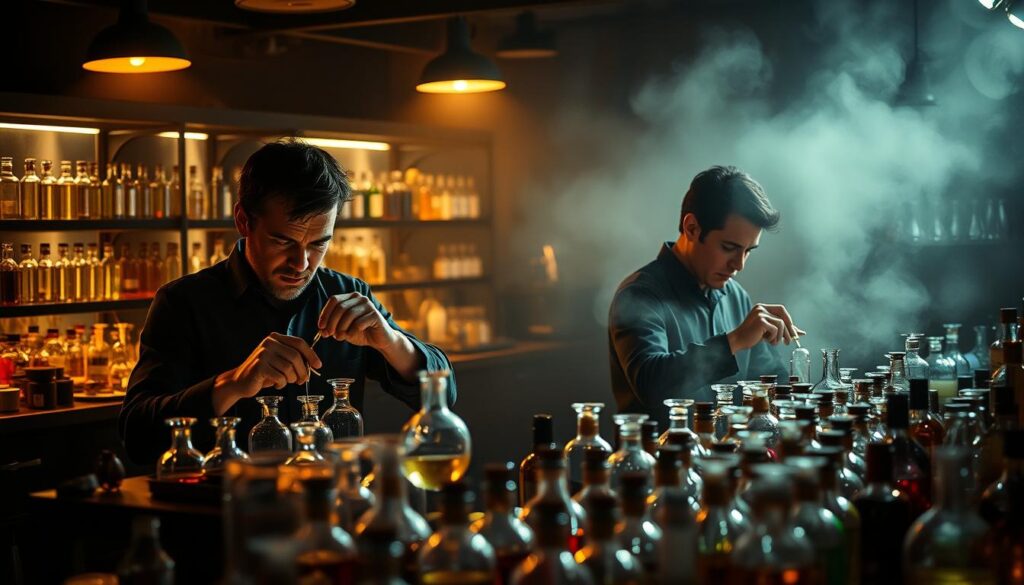
A perfumer’s journey starts with learning about ingredients. They study what each one does and how they work together. This knowledge is key in perfumery techniques. They might mix hundreds or even thousands of essences to get it just right. Below is a table showing how different scents have different amounts of essences.
| Fragrance Type | Concentration of Essential Oils |
|---|---|
| Perfume | Up to 40% |
| Eau de Toilette | Up to 15% |
| Cologne | Approximately 10% |
| Unisex Fragrances | Varies widely, aligning with consumer demand for flexibility |
The work doesn’t end in the lab. After the master perfumer likes the initial mix, it ages. This could take months or even a year. This step helps all the parts mix well on a deep level, making the scent last longer.
Also, there’s a move towards greener perfumery techniques now. Around 60% of buyers think about the environment before buying a scent. This is pushing the industry to use natural and ethically gotten ingredients more.
The skill of these master perfumers is always changing but holds onto tradition too. It’s their talent that helps us find our favorite scents. These smells are part of our daily life and special moments. They also help express who we are and what we like, impacting trends and cultures.
Blending Science: How Fragrance Components Are Combined
The perfume blending process combines many scents to make complex fragrances. It’s key to understand perfume chemistry. This includes knowing how to mix top, middle, and base notes. This skill helps create perfumes that make a lasting impact right when they’re applied.
Top notes hit you first when you smell a perfume. They vanish quickly but start the fragrance journey. Getting these to work well with longer-lasting middle and base notes is crucial.
Next, middle notes become noticeable. They show the perfume’s main character after the top notes dissipate. These scents are softer and set the stage for the rich base notes that last a long time.
It’s important to know how fragrance molecule volatility works. This helps figure out how each scent mixes over time and the scent’s lasting power. How the fast-evaporating top notes blend with the strong base notes, balanced by the middle notes, creates the fragrance’s unique smell.
A successful fragrance is made by choosing compatible scents in the right amounts. The table below shows how the amount of fragrance oils affects the perfume’s interaction with the skin. It changes how the scent develops through the day.
| Perfume Type | Fragrance Oil Concentration |
|---|---|
| Parfum (Perfume) | 20–30% |
| Eau de Parfum (EDP) | 15–20% |
| Eau de Toilette (EDT) | 5–15% |
| Eau de Cologne (EDC) | 2–5% |
| Body Mists or Sprays | Less than 3% |
This table shows why fragrance concentration levels matter. Lower concentrations mean a lighter scent for day-to-day wear. Higher concentrations offer a stronger scent that lasts, perfect for the evening or special events.
In conclusion, making perfume is not just about mixing scents. It’s also about understanding how scent concentration impacts evaporation and scent interaction over time.
Aging and Maturation: Perfecting the Perfume
In the fascinating world of making perfumes, perfume aging process is key. It lets the perfume get its full aroma and stability. It happens in a cool, dark place over time, using advanced scent formulation techniques.
This phase lets ingredients mix and create new or stronger scents. It’s vital in making the perfume’s layers and can take up to a year. This step is all about precision and patience, making sure each scent is rich and complex.
| Time Frame | Key Process | Impact on Fragrance |
|---|---|---|
| 0-2 Months | Initial Maturation | Development of primary scent notes |
| 2-6 Months | Chemical Stabilization | Enhancement of fragrance stability and blending of notes |
| 6-12+ Months | Deep Maturation | Maximal expression of complex bouquet, richness, and depth |
The maturation also involves techniques for scent preservation in perfumes. Choosing where to store them is key to stop them from going bad. Sometimes, additives help keep the scent fresh longer.
The science and care in scent formulation techniques and storage make a perfume special. It means each bottle is not just a scent but an experience. This shows the quality and innovation in today’s perfume making, blending old ways and new tech.
Filling and Packaging: The Final Steps in Perfume Making
The journey of perfume ingredient extraction and fragrance formulation ends with filling and packaging. This final step is key to ensuring a premium experience for the consumer. After creating and aging the fragrance, it undergoes strict quality control in perfume production. This makes sure each bottle meets the brand’s high standards of excellence and allure.
The packaging design needs to protect and maintain the fragrance. It should also look attractive to customers. Quality packaging influences buying decisions by adding luxury and uniqueness to the product. Also, around 74% of consumers would spend more on products with eco-friendly packaging. This shows a shift towards sustainable options in perfume making.
Quality control is top priority. It includes checks for leaks, defects, and scent accuracy in each bottle. Companies like ONE SEED focus on in-house quality control and follow strict safety regulations. This shows their dedication to quality and consumer safety.
Here are key statistics highlighting the critical aspects of perfume manufacturing:
| Aspect | Detail |
|---|---|
| Production Timeframe | 1 week to 1 month |
| Quality Assurance | Dedicated teams overseeing stringent standards |
| Impact of Design | Premium packaging enhances brand distinction |
| Consumer Preferences | 74% favor eco-friendly packaging |
| Testing Protocols | Extensive fragrance performance tests on skin and fabrics |
Finishing the packaging process makes the perfume ready for sale. It also defines the brand’s identity and its commitment to sustainability. The move towards natural and harmless fragrance formulations highlights the need for clear and responsible packaging.
The Psychological Influence: How Scents Affect Us
Scents deeply affect our emotions and mood, more than we might think. Scent memories and emotions are closely linked. This is because our sense of smell connects directly to the brain’s emotion areas. The effect of perfume on our mood is both big and measurable.
A perfume is not just a nice smell. It’s a key that unlocks memories, using scent’s power to take us back in time. A fragrance’s emotional impact can stick with us, reaching into our memory banks where we keep our experiences and feelings.
Scent Memories: Connecting Fragrances with Emotions
Our brain links smells with specific memories strongly. Just a sniff of certain scents can bring back a flood of memories. The fresh smell of lemon might remind you of a summer day. The scent of vanilla may take you back to baking with someone you love. Perfumes bring back not just the moment, but also the feelings we had then.
The Power of Perfume to Influence Mood and Perception
Perfumes can directly change our mood and how we see the world, thanks to their chemical makeup. For example, lavender can calm us down, while peppermint can make us focus better. This shows how perfumes can really affect our mood and brain work.
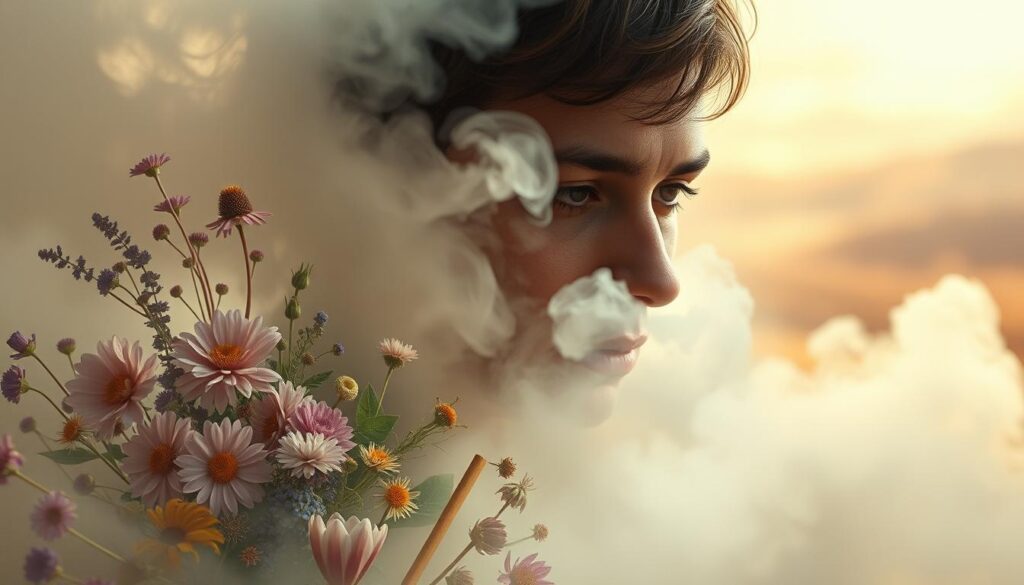
Humans have about 300 special genes for smelling different scents. This makes the study of scents and their effects on us very broad. The way smells link to our feelings shows how big perfume’s impact can be on our daily lives.
Understanding how deeply scents influence us makes us appreciate perfumes more. It also shows us how using scents smartly can set the mood we want in our personal and work spaces.
Future Trends and Innovations in Perfume Manufacturing
The world of perfume is changing fast, thanks to new trends in perfume science and technology. There’s a big push for sustainable perfumery too. We’re seeing big leaps in how fragrances are made and an effort to be kind to our planet.
Advancements in Aroma Chemistry are leading new changes in perfumes. Techniques like Gas Chromatography-Mass Spectrometry (GC-MS) and Molecular Distillation make perfumes purer and give creators new smells to work with. GC-MS helps make sure every perfume smells the same. Molecular Distillation strengthens the smell.
Artificial Intelligence is also making a big splash in perfume making. Now, over 40% of perfume brands use AI to make better scents. This is because AI can figure out what people like to smell. Around 70% of folks are open to trying scents AI suggests.
Sustainability and Ethical Sourcing in Perfumery matter more now as people care about the planet. The industry is moving towards things like waste-free packaging and ethical material sourcing. This shows they’re serious about protecting the environment. Using biotechnology helps make eco-friendly ingredients that still smell great.
Brands like Estée Lauder and Future Society are leading with innovation and care for the earth. Estée Lauder uses tech to find the right perfume for your face. Future Society uses science to recreate smells from flowers that no longer exist. These steps show how perfume making is becoming more responsible.
The perfume industry is becoming more personalized and eco-friendly. It’s showing that luxury and caring for the earth can go hand in hand. With these advances, the future of fragrance looks bright and green.
Conclusion
The art and science of making perfume is a mix of old traditions and new science. Making perfume blends chemistry and art, taking months or even years. It’s like a symphony. Aromatic compounds lead, solvents like ethanol join in, and fixatives keep the scent strong.
The growing perfume industry faces environmental challenges. Customers want eco-friendly practices, ethical sourcing, and products not tested on animals. Making essential oils for perfumes combines science and care for the environment. The industry follows strict standards for consumer health and product safety.
Perfume makers use both old techniques and new technology to create scents. Sustainability drives the industry to find innovative, eco-friendly ways to make perfumes. Every perfume spritz is a fleeting work of art. It tells a personal and shared story, crafted with care and respect for nature. Perfumery is evolving, charming, and innovating, aiming to make a lasting impact without harming the environment.

